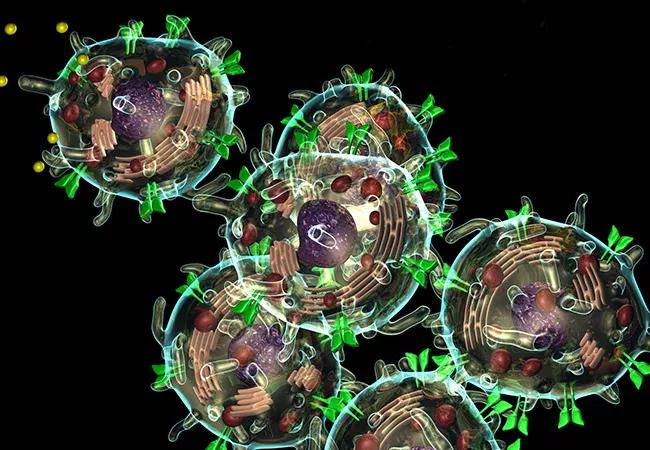Experience to date highlights need for immunotherapy focus

Years of Cleveland Clinic experience with patients receiving chemoradiation with temozolomide for newly diagnosed glioblastoma adds to evidence of the detrimental role of immunosuppression and supports the need to preserve or bolster the immune system while treating this devastating disease. So indicate two studies presented May 7 at the 2019 annual meeting of the American Academy of Neurology.
Advertisement
Cleveland Clinic is a non-profit academic medical center. Advertising on our site helps support our mission. We do not endorse non-Cleveland Clinic products or services. Policy
One study, reported in a platform presentation, found that low absolute lymphocyte levels (< 300/mm3) predict significantly poorer survival. A second study, presented as a poster, found no significant survival advantage to extending adjuvant temozolomide therapy beyond the standard six cycles, a result that supports limiting this potentially immunosuppressive therapy to the standard regimen for most cases.
“Immunosuppression, inflicted by the glioblastoma tumor itself and further aggravated by current therapies, impacts patient survival,” says neuro-oncologist Manmeet Ahluwalia, MD, of Cleveland Clinic’s Rose Ella Burkhardt Brain Tumor and Neuro-Oncology Center and principal investigator of the studies. “It’s our challenge to improve existing treatments and find new ones that minimize immunosuppression and enhance the immune system in order to better fight this aggressive cancer.”
Glioblastoma is the most common type of brain tumor, and most patients survive only about 15 months after diagnosis despite surgery, radiation and chemotherapy. Temozolomide, approved in the U.S. for treatment of glioblastoma in 1999, continues to be the sole chemotherapy agent available that is associated with survival benefit.
The first study retrospectively reviewed 158 patients who underwent surgery followed by standard care with concurrent temozolomide chemoradiation. Blood for absolute lymphocyte count testing was collected at the time of surgery, on the chemoradiation therapy start date, and at intervals up to 10 weeks thereafter. Absolute lymphocyte counts were analyzed for association with age, sex, MGMT methylation status and extent of surgical resection.
Advertisement
The study found that patients with absolute lymphocyte counts below 300/mm3 had a median survival of just 3.5 months compared with 16 months for those with higher counts (P = 0.0007). The adjusted hazard ratio was 0.358 (P = 0.006) for progression-free survival and 0.297 (P = 0.002) for overall survival.
“Each component of standard treatment for glioblastoma — radiotherapy, chemotherapy and steroids — contributes to immunosuppression by lowering the absolute lymphocyte count,” explains Dr. Ahluwalia. “Pursuing different treatment strategies, including minimizing steroid use and reducing radiation exposure, may minimize this effect and improve outcomes, particularly in the era of immunotherapy.”
The second study examined the frequent practice of extending adjuvant temozolomide therapy for patients who can tolerate it and have no evidence of tumor progression. Following surgery for newly diagnosed glioblastoma, the standard Stupp protocol specifies six weeks of temozolomide chemoradiation followed by six cycles of adjuvant temozolomide. Whether to extend therapy beyond six cycles is left to physician discretion.
But research on the value of extended adjuvant temozolomide therapy has been mixed. The largest study, using pooled data from more than 2,000 patients from four randomized trials, found that progression-free survival was somewhat improved, especially for patients with methylated MGMT, but overall survival was unaffected (Neuro Oncol. 2017;19:1119-1126).
The current study retrospectively assessed Cleveland Clinic data from 60 patients newly diagnosed with glioblastoma from July 2012 through September 2016 who were treated with surgery followed by six weeks of temozolomide chemoradiation and then by six or more additional cycles of adjuvant temozolomide.
Advertisement
Median overall survival was found to be 22.47 months for patients who received six cycles of adjuvant temozolomide compared with 25.76 months for patients who received more than six cycles, a difference that was not significant (P = 0.61). Patients who received more than six cycles had a hazard ratio for progression-free survival of 0.80 (CI = 0.37-1.73; P = 0.57) and a hazard ratio for overall survival of 1.62 (CI = 0.72-3.66; P = 0.24).
“We found no evidence that extending adjuvant temozolomide beyond the standard six-cycle protocol improved outcomes,” says Dr. Ahluwalia, who notes that the dataset was not large enough to detect potential survival differences from extended therapy according to MGMT status.
“These findings were in line with the current literature,” he adds, “and provide additional support for limiting extra exposure to temozolomide with its accompanying immune-suppressive effects, particularly for patients participating in immunotherapy trials.”
Clinical trials are underway at Cleveland Clinic to evaluate the role of immunotherapy for glioblastoma treatment, he notes. These include a phase 2 randomized, open-label study comparing nivolumab plus standard-dose bevacizumab with nivolumab plus low-dose bevacizumab in patients with recurrent glioblastoma (NCT03452579). “This study is using bevacizumab to avoid steroid use to mitigate the immunosuppression seen with steroids in this patient population,” he explains. Another trial is using low-dose capecitabine plus bevacizumab to target myeloid-derived suppressor cells in patients with recurrent glioblastoma (NCT02669173).
Advertisement
“Research findings have indicated the importance of optimizing the immune system to effectively fight glioblastoma,” adds Dr. Ahluwalia. “We are hopeful that immunotherapies currently being investigated will lead to strategies that can give our patients better outcomes.”
Advertisement
Advertisement

First-of-its-kind research investigates the viability of standard screening to reduce the burden of late-stage cancer diagnoses

Global R&D efforts expanding first-line and relapse therapy options for patients

Study demonstrates ability to reduce patients’ reliance on phlebotomies to stabilize hematocrit levels

A case study on the value of access to novel therapies through clinical trials

Findings highlight an association between obesity and an increased incidence of moderate-severe disease

Cleveland Clinic Cancer Institute takes multi-faceted approach to increasing clinical trial access 23456

Key learnings from DESTINY trials

Overall survival in patients treated since 2008 is nearly 20% higher than in earlier patients